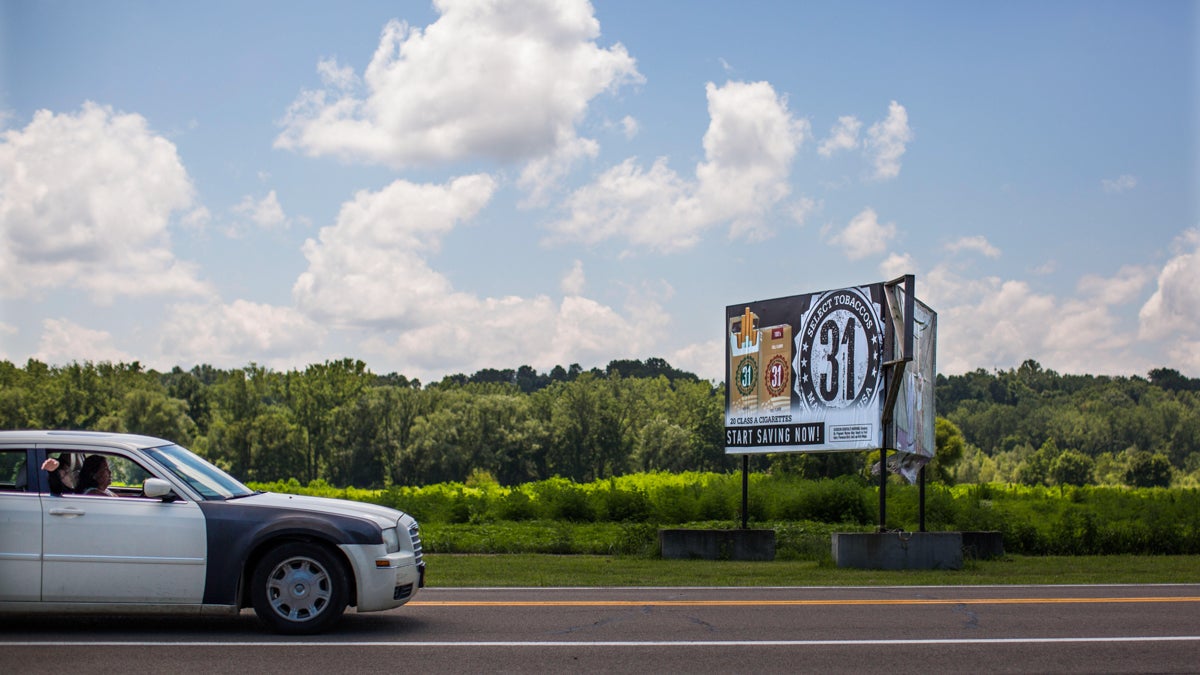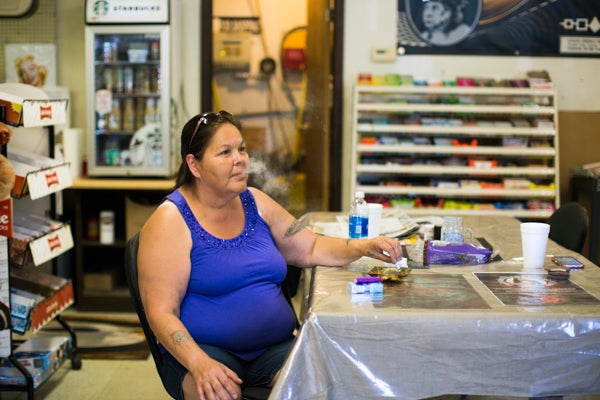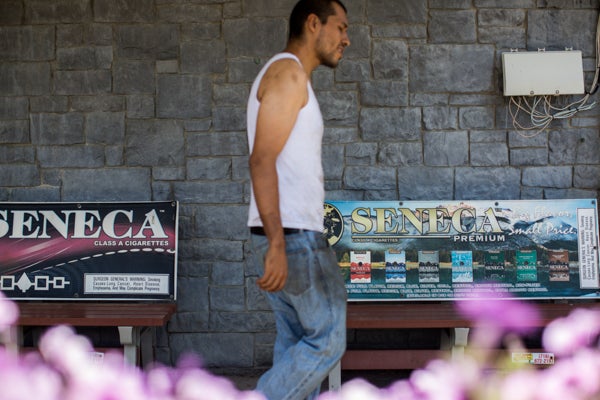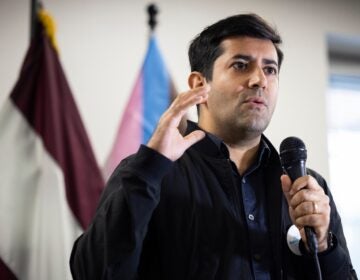Tribes hope tradition will fight unhealthy tobacco use
Listen
A billboard advertises discounted cigarettes adjacent to a field used to grow tobacco on the Seneca Nation's Cattauragus reservation in Western New York. (Photo by Jessica Kourkounis/for WHYY)
Cheap tribal cigarettes can complicate tobacco control on reservations.
States and cities have come to understand that if they jack up the taxes on cigarettes — teenagers especially have a harder time buying them.
This year, the National Cancer Institute and World Health Organization concluded that a big price increase is one of the most effective tools for decreasing tobacco use. But there are certain communities where relatively cheap cigarettes are still easy to get.
In western New York, where I grew up, there is at least one place to avoid paying high prices: on the reservations of the Seneca tribe.
When I was a kid I spent a lot of time with my friend Erin Horton. I hadn’t seen her or her mom in almost 12 years but I met up with them when I traveled home to report this story.
Erin lives 30 miles south of Buffalo with her husband and two kids, about a 10-minute drive from the Seneca’s Cattaraugus Indian reservation.
When we were teenagers, back in the early ’90s, we thought smoking was cool. We also thought going to the “res”, as we called it, was cool. It was somewhere we wouldn’t get carded and smokes and gas were cheap.
Erin came with me to reminisce about our youth and to check out some of the gas stations and smoke shops we used to frequent.
“A pack was maybe what, like two dollars?” I ask her.
“A dollar or two at most,” she said.
“I remember buying American spirits and thinking they were like …” and we both chime in “healthy cigarettes!”
Erin celebrated a little the first time she read the label, she thought it said “addictive free” — it actually said additive free.
Our first stop is Wolf Run. The place reminds you of a highway truck stop with kitschy trinkets, snacks, gas and of course, cigarettes, cigars and chewing tobacco. It looks about the same as it did when I was 17, but with one difference. They no longer carry national brand cigarettes like Camels or Marlboros. Now the stock is all Indian-produced cigarettes.
We ask the clerk what kind of cigarettes they carry and he lists off a few options.
“We have the Sands, these are $3. Then we’ve got these King Mountains they’re menthols they taste exactly like a Newport. The Senecas, those are $2.75 and they’re not bad, they’re actually made on this res,” he says.
We pick out one pack of 31 Blues and some premium Senecas.
“That’ll be $5,” he says.
Back in the car, Erin and I take a closer look at the cigarettes we just bought. Two packs cost $5. If we’d bought a pack of Camels just outside the reservation it would cost us $10.31.
Why such a big difference?
Taxes.
There are more than 500 tribes across the country. Each is a sovereign nation and they set their own rules. For example, the New York state cigarette tax is $4.35 per pack, but smoke shops on Seneca reservations don’t add on that extra tax, which keeps prices lower.
Our next stop is a smaller gas station called Crossroads where we meet attendant Marianne. She was just sitting down for a smoke break and waiting to pump gas.

Marianne, a gas attendant, smokes a Seneca brand cigarette at Crossroads station on the Seneca Nation’s Cattauragus reservation in Western New York. (Photo by Jessica Kourkounis/for WHYY)
“Oh that’s a good cigarette,” she says laughing. But her laugh turns into a cough and she says, “and that comes from smoking a cigarette.”
Marianne, now in her late 50s, says she started smoking when she was 11 years old. That’s over four decades of smoking.
I was hoping to ask Seneca Nation officials about the low tobacco prices and the health costs of smoking among tribe members but they declined my request for an interview.
As a group, American Indians and Alaska Natives have the highest cigarette smoking rates compared to all other racial and ethnic groups in the United States. That’s according to the Centers for Disease Control and Prevention.
Kristine Rhodes, an enrolled member of Bad River Band of Lake Superior Chippewa tribe, leads the American Indian Cancer Foundation.
She doesn’t have information about the Seneca nation policies but she says that it is not the case that there are cheaper cigarettes in all tribal communities.
Another thing to consider: Health research shows that across decades, cigarette companies have targeted American Indians by funding cultural events such as powwows and rodeos and by using Native American images in advertising and packaging.
There’s not a lot of health research on tribal retail spaces, Rhodes says there is at least one study underway.
“Smoking rates among American Indians and Alaskan Natives vary tremendously by region and by tribe,” she says.
For example, in the Southwest United States, American Indians have the lowest smoking rates, even lower than mainstream America.
“This is really great news that we celebrate and we see a corresponding lower cancer rate there for smoking-related cancers,” Rhodes said.
At the same time, the Northern Plains and Alaska are two areas with higher rates of commercial tobacco use nicotine addiction and corresponding rates of tobacco-related cancers.
The Cancer Foundation is working on control policies around the nation. But tobacco sales are big money for some tribes and Rhodes says a readiness to change is different from community to community.

A man passes benches advertising Native brand cigarettes outside a gas station on the Seneca Nation’s Cattauragus reservation in Western New York. (Photo by Jessica Kourkounis/for WHYY)
Indian tribes can set more stringent or less stringent rules than those of the state where they are located.
“This can impact tobacco sales price or tax, as well as indoor smoking restriction, and there is a great deal of variability when it comes to 567 tribes,” she says.
“We know that price matters both for young people who are thinking about starting smoking, as well as for people who are addicted to nicotine and want to quit smoking. If cigarettes are cheap, there’s less of an incentive to quit,” Rhodes says.
No health research yet, but there is a movement that Kristine Rhodes and others think might decrease rates of smoking among native people. The plan is to help people give up unhealthy habits while holding on to native traditions. And that includes using and reclaiming sacred traditional tobacco.
“Tobacco control in tribal communities is super complex,” Rhodes says.
Traditional tobacco is grown and prepared without chemicals, different from the commercial tobacco used in mass-market cigarettes. Native rituals vary. Sometimes tobacco is placed near rocks or worn in a pouch on the body.
“My children and I, we will offer our tobacco to Mother Earth like to the trees or the water to be thankful for a new day. Some tribal communities also use tobacco for weddings,” says Coco Villaluz, a community educator for the nonprofit organization ClearWay Minnesota.
She says traditional tobacco is offered as a sign of respect. It’s often used without burning the plant, other times it is smoked in a pipe to carry prayers to the Creator.
“Historically, that is done through ceremonies,” Villaluz says.
For decades, a federal law cut American Indians off from many religious practices and prevented many people from using sacred tobacco.
During that time, Villaluz says native people often switched to commercial tobacco.
Today, Villaluz urges people to reject commercial tobacco and stop using it for ceremonies and prayers. Her organization offers people help to quit smoking. And the group also advocates for smoke-free areas on Indian lands.
“We all want the same mission as everybody else who’s working on tobacco, whether it’s in tribal communities or non-tribal communities. We want our people to be healthy, we don’t want to see any more of our loved ones suffering from commercial tobacco related illnesses,” she says.
WHYY is your source for fact-based, in-depth journalism and information. As a nonprofit organization, we rely on financial support from readers like you. Please give today.







